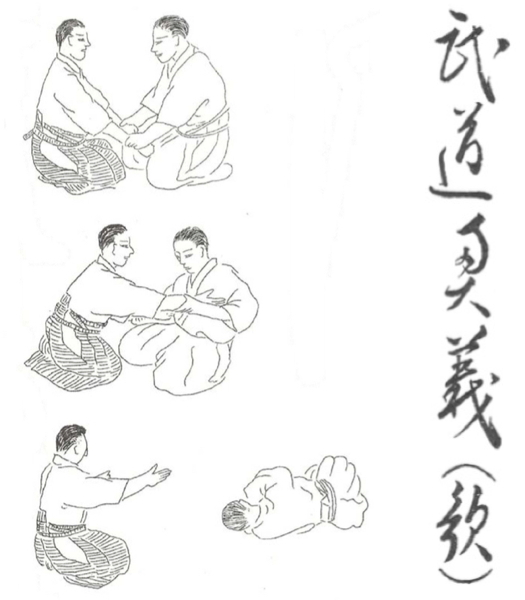 “The Secret Teachings of Budo (Poems)” – From “Budo Renshu” – 1933
“The Secret Teachings of Budo (Poems)” – From “Budo Renshu” – 1933
The 1933 training manual “Budo Renshu” (published in English under the name “Budo Training in Aikido“) was initially given to the students of Aikido Founder Morihei Ueshiba as a kind of a teaching license.
It was filled with illustrations depicting techniques (such as the one above) taught at the Kobukan Dojo which were drawn by Takako Kunigoshi, a student at the Kobukan who began training shortly before her graduation from Japan Women’s Fine Arts University.
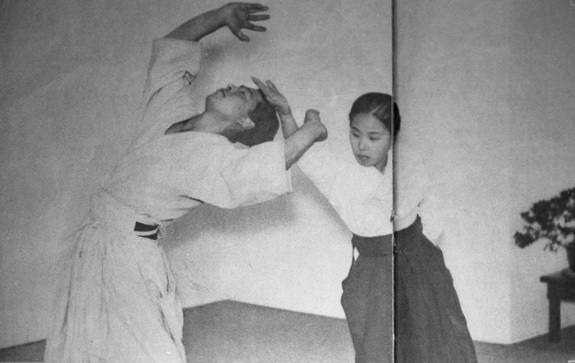
Takako Kunigoshi and Shigemi Yonekawa
It is believed that the sections of text were assembled by Kenji Tomiki, under the direction of Morihei Ueshiba.
Among the text that precedes the technical portion of the manual is a section entitled “The Secret Teachings of Budo (Poems)” that contains many of the Doka (“Poems of the Way”) written by O-Sensei.
There is a similar collection in the 1938 technical manual “Budo”. A loose translation of “Budo” was published in English under the name “Budo: Teachings of the Founder of Aikido” by John Stevens. There is also a commentary by Morihiro Saito published under the name “Budo: Commentary on the 1938 Training Manual of Morihei Ueshiba“, but if memory serves that edition did not include the Doka.
Together, those two collections make up the bulk of the pre-war Doka that exist today. There are also a number of Doka that appear in the post-war works of Morihei Ueshiba such as “Takemusu Aiki” (a highly abridged version of which was published by John Stevens as “The Heart of Aikido: The Philosophy of Takemusu Aiki“).
The Doka are often quoted without context or explanation (for example, as they appear in John Stevens’ “The Art of Peace: Teachings of the Founder of Aikido“, or in various internet memes).
Why are they important?
Just like the man said – these are “The Secret Teachings of Budo (Poems)” – Morihei Ueshiba encoded many of the inner teachings of his art in these short poems.
Actually, it was/is a very common practice in China and Japan to preserve knowledge (particularly martial knowledge) in the form of poems or “songs” for future generations – and Morihei Ueshiba was no exception.
For example, here is one that was quoted by Morihei Ueshiba, who often stated that it contains the secret of Aikido:
来たれば即ち迎え、去れば即ち送り、
対すれば即ち和す。
五五の十
二八の十
一九の十
是を以て和すべし。
虚実を察し、陰伏を知り、
大は方処を絶ち、細は微塵に入る。
殺活機にあり、変化時に応ず。
事に臨んで心を動ずること莫(なかれ)や。If it comes, then meet it, if it leaves, then send it away.
If it resists, than harmonize it.
5 and 5 are 10.
2 and 8 are 10.
1 and 9 are 10.
You should harmonize like this.
Intuit true and false, know what is hidden,
The large suppresses all, the small enters the microscopic.
There are chances for life and death, without reacting to changes.
Approach things without moving your heart (without being disturbed).
The above is a passage from a Chinese text on strategy that is more than 900 years old – for a more detailed discussion about that you may want to read “Kiichi Hogen and the Secret of Aikido“.
For some some other examples, let’s take a look at a few of Morihei Ueshiba’s classic Doka here, and then take a brief look at how he further encoded his training method for future generations.
Here is the first Doka…
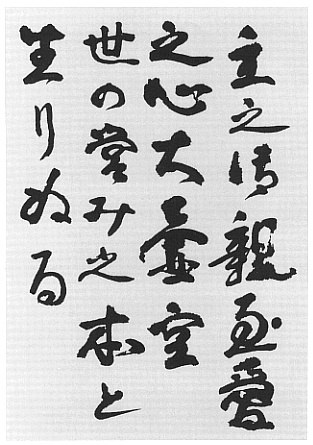
Doka and calligraphy by Aikido Founder Morihei Ueshiba
主之御親至愛
之心大壺空
世の営み之本と
生りぬる
“The spirit of the great love of the divine parent Su-,
vast and limitless.
It is the origin of the workings of the world“
“Su-” (主) has one of those layered meanings that the Founder was so fond of using. While it is sometimes translated as “Lord” (we’ll see a place where that happened later on in this article), according to Seiseki Abe, the Founder’s calligraphy teacher (the original of the calligraphy above belonged to Abe Sensei), it represents two things – “breath” and Amenominakanushi (天御中主).
Let’s start with Amenominakanushi – the “Diety at the Absolute Center of Heaven” – the Founder said that this diety represents you, yourself.
Amenominakanushi was the first Kami to come into being on the “High Plain of Heaven” (“Takamagahara” / 高天原).
Where is the High Plain of Heaven?
Here’s what Masahisa Goi had to say about it:
高天原がここにあるんですよ。みんなの体ですよ。
Takamagahara is right here. It’s everyone’s body.
Goi Sensei was a close friend of Aikido Founder Morihei Ueshiba. The Founder once said that Goi was the only person who truly “knew his heart”. He was also the inventor of the Peace Prayer.
But there’s more about that, the Founder himself was quite specific:
タカマガハラも自分にあるのであります。天や地をさがしてもタカマガハラはありません。それが自己のうちにあることを悟ることであります。
“Takamagahara is within yourself. If you search for Takamagahara you will not find it on Heaven or Earth. That is when you will become enlightened to the fact that it exists within yourself.”
Morihei Ueshiba
Amenominakanushi manifests in a triumvirate with Takamimusubi (representing “Yang” or “Heaven”) and Kamimusubi (representing “Yin” or “Earth”).
In other words, “Heaven-Earth-Man”, a.k.a. the “Sangen” (“Three Origins”) in “Sangenkai“. Yin and Yang opposing forces matched inside the body, inside oneself.
Further, these forces are bound together by “great love”. Here’s how that works out:
- Love is “Ai” = 愛 or “A”+”i”.
- “A”+”i” = 天 + 意, or the “intent of Heaven”
The technical reading here is that Yin and Yang are manifested as opposing forces through intent, and this is the source of the “workings of the world” – this is how things move, how things work.
Now, before somebody says “well, what about the love part?” – there’s a multilayered meaning here that makes everything work out!
- According to Morihei Ueshiba’s teacher Onisaburo Deguchi there is selfish (“bad”) love and unselfish (“good”) love, and the love of the Kami is unselfish (“good”) love.
- Kami is written “K+a” and “M+i”. In other words, “Kami” is “Ai”, which is both “love” (the good kind!) and “heavenly intent”.
So we see that when Morihei Ueshiba said “Aiki is the study of intent” (合気は魂の学びである) and when he said “Aiki is love” (合気は愛なり) that he was referring to intertwined concepts in a phrase with multi-layered imagery.
That crossover between “intent” and “love” is actually key concept for Morihei Ueshiba, but that’s deep enough in that direction for the time being. Moving back on track…here’s a note about Heaven-Earth-Man in the Chinese arts before we move on to fire and water:
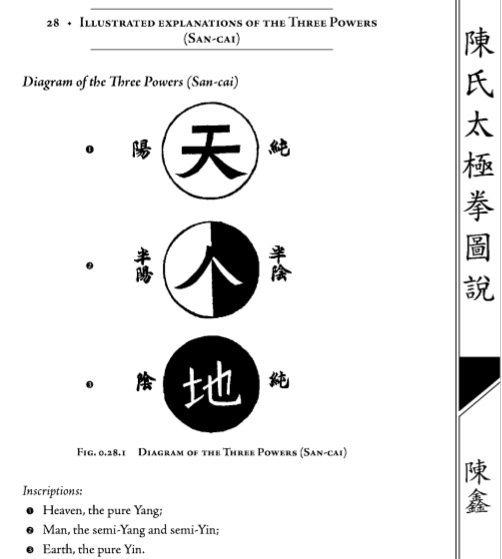
Heaven-Earth-Man – from “Illustrated Explanations of Chen Family Taijiquan”
From this fundamental triad, many other triads can be developed to explain internal arts and internal training. Heaven’s energy (yang qi) flows downward and is received by Earth. Earth’s energy (yin) flows upward. The two interact and co-mingle in living things.
Tom Bisio: “What is an Internal Art?“
Now, let’s get to the “breath” part – if you remember, that was the second element represented by Su-, according to Seiseki Abe.
“Su is the beginning of universal breath, movement and power.
“The Spiritual Foundations of Aikido“, by William Gleason
Breath” is “Iki” – which is commonly written 息, but that the Founder said was composed of the characters for “water” and “fire” (水火). According to Seiseki Abe what is being referred to in this Doka is the breathing in which fire and water are concentrated and mixed in the tanden (丹田).
火・水(カ・ミ)の動きによって中心ができる。中心ができるから万物の生「イキ」がある。これが水火の恵みという。
It is through the movement of Fire and Water (“Ka” + “Mi”) that the center is created. It is because the center is created that the life (“Iki”) of all things exists. This is called the blessing of Water and Fire (“Iki”).
Aikido Founder Morihei Ueshiba
Oral transmission to Bansen Tanaka
As seen above, “Fire and water” were often spoken about as “Kami” by the Founder (adding more layers to the multilayered encodings that the Founder delighted in using). “Kami” also means “God”, and of course the Founder often spoke of the Shinto gods as well, which illustrates the importance of background knowledge when attempting to put the speeches and writings of the Founder in context.
Fire and water, by the way, didn’t originate with Morihei Ueshiba, they came from China – and from India before that. In China they are an integral part of the internal martial arts (as they were integral to Aikido for Morihei Ueshiba):
On the most basic level, internal martial arts and internal exercises focus on engaging with the two fundamental forces in the body, water and fire, the archetypal expressions of Heaven (yang) Earth (yin) which move within human beings. These forces have a relationship with the kidneys (water) and the heart (fire).
Tom Bisio: “What is an Internal Art?“
There is a more detailed discussion of this internal process in Tom Bisio’s article “Daoist Meditation Lesson Seven Theory: Three Treasures and the Circulation of Water and Fire“. Also, there is more about Morihei Ueshiba’s thoughts on the matter in “Morihei Ueshiba and the Way of the Cross“.
In any case, now we can see that the original Doka refers to the basic Chinese cosmology of the world – Heaven and Earth, Water and Fire, Heaven-Earth-Man, and we see from the context provided that this cosmology is presented in the context of internal training, martial internal training.
Yin and Yang manifested as opposing forces through intent within one’s own body.
For reference, here is a translation of the same Doka translated by John Stevens, that appeared in “The Essence of Aikido: Spiritual Teachings of Morihei Ueshiba”:
SU, Exalted Father
with a heart of love
as vast as the sky–
it is the source of all that
functions in this world.
Actually, the differences in translation here are not that large, but perhaps you can see that it is difficult to divine the meaning represented by the Doka from a stand alone reading.
Moving on to the second Doka…
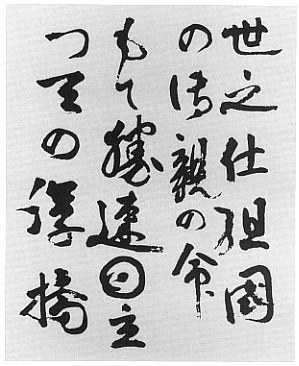
Doka and calligraphy by Aikido Founder Morihei Ueshiba
「世の仕組國
の御親の命
もて勝速日立
つ天の浮き橋」
“Take the life given to you by the divine parents
of the nation and the structure of the world,
and swiftly
stand on the Floating Bridge of Heaven”
According to Seiseki Abe (the original of this calligraphy belonged to Abe Sensei as well), the “divine parents of the nation” are the three creator gods of the Kojiki that we saw in the first Doka – Amenominakanushi (representing “Man” – or oneself), Takamimusubi (representing “Yang” or “Heaven”) and Kamimusubi (representing “Yin” or “Earth”), the foundation of the “Aiki O-Kami” – the “Great Gods of Aiki” (along with the five generations of earthly deities / 地神五代 and the seven generations of heavenly deities / 神代七代).
Once again – the Heaven-Earth-Man model that we saw above.
This may be of interest to Aikido folks, since one of the definitions of Aikido given by the Founder in the first chapter of “Takemusu Aiki” is 「合気道は天地人和合の道と理なり。」 – “Aikido is the Way and Principle of harmonizing Heaven, Earth and Man.”
The mini-diagram of Heaven-Earth-Man that we see here was expressed by the Founder as the “Ame no Uki Hashi”, the “Floating Bridge of Heaven” (also mentioned above).
Here’s a fun fact – “Takemusu Aiki” is the largest and most reliable collection of the Founder’s lectures. The most common phrase in “Takemusu Aiki” is not “Takemusu Aiki”, not “Love”, not “Harmony”, not even “Aiki” – it’s “Ame no Uki Hashi”, which may tell you a bit about it’s importance as a model of Morihei Ueshiba’s method:
合気道はまず天の浮橋に立たなければならないと言われる。天の浮橋とは火と水の交流という。丁度十字の姿、火と水の調和のとれた世界である。つまり高御産巣日、神産巣日二神が、右に螺旋して舞い昇り、左に螺旋して舞い降り、この二つの流れの御振舞によって世界が出来たという。火と水でカミになり、このカミ(火と水)の根源は一元に帰るが、一元から霊魂の源、物質の根源が生まれる。
It is said that Aikido must first stand on the Floating Bridge of Heaven. It is said that the Floating Bridge of Heaven is the exchange of Fire and Water. Precisely in the form of a cross, it is the world of Fire and Water in harmony. In other words, it is said the this world is created through the two actions of the twin gods Takami-Musubi and Kami-Musubi winding up in a spiral on the right and winding down in a spiral on the left. Fire (“Ka”) and Water (“mi”) become “Kami”, the source of this “Kami” (Fire and Water) returns to the one, but the one becomes the source of the physical and the spiritual.
Even those who trained with the Founder directly had a hard time dissecting this. A direct student of Morihei Ueshiba O-Sensei once expressed it to me this way:
The Founder told us that we would be unable to practice martial arts if we did not stand on the Floating Bridge of Heaven. We were told that if we could not stand on the Floating Bridge of Heaven then our training would not bring forth Aikido technique, so it was essential that we do so at all costs.
However, we didn’t understand anything about where this Floating Bridge of Heaven was. Since we didn’t understand where it was there was no way that we could stand on it, so the reality was that we just put on a good face and kept on applying techniques to each other.
I’ll leave a detailed discussion of the Floating Bridge of Heaven alone for now, except to say that he was essentially talking about the basic model of Yin-Yang (in-Yo) matched opposing forces. You can find out more about the Floating Bridge of Heaven in these articles:
- “Aikido and the Floating Bridge of Heaven“
- “More on Aikido and the Floating Bridge of Heaven“
- “Morihei Ueshiba and the Way of the Cross“
So…the Doka above is describing the basic structure of Yin-Yang forces at work, the classical Chinese structure that moves from the structure of the world to the structure of the nation to the structure of the individual (the “life”).
Then, it instructs you to “stand on the Floating Bridge of Heaven”, which as we saw above, the Founder stated as an absolute requirement for producing “Aiki”.
For the Founder, as in the classical Chinese model, the structure of the universe was linked and mirrored in the government and the individual.
Note that the Founder states above that this model is the source of both the physical and the spiritual..
In other words, the physical practice of Aiki is linked to, and inseparable from, both spiritual and cosmological Aiki.
For reference, here is the commonly published translation of the same Doka. This is the one that is part of a list edited by Seiseki Abe – but not translated by him:
“Build up the world”
This command he did grasp
Received from the honored mother of the nation
Thus stands Katsuhayabi
On the Floating Bridge of the Heavens
That there are some differences in translation ought to be immediately apparent. Note that this translation misses some of the references, making some of the implications quite different.
Moving on to the third Doka…
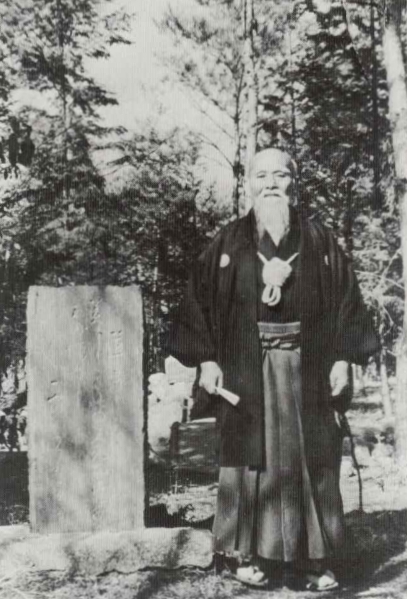
Stone monument at the Aiki Jinja in Iwama
The inscribed Doka is by Aikido Founder Morihei Ueshiba
calligraphy by Seiseki Abe
「美しき
この天地の御姿は
主の作りし
一家なりけり」
“So beautiful,
the form of this Heaven and Earth
created by Su-
to be a member of the one family”
As noted above, “Su-” is “breath”, composed of fire and water, which represents Amenominakanushi – whom the Founder identified as representing oneself.
In other words, the Founder is again talking about “Heaven-Earth-Man”, here as a method of internal training that creates a unification of opposing forces (Heaven and Earth, Yin and Yang) inside Man, inside oneself, and that this process is a path to creating better human beings – those who have the capability to form the world family.
So here we have a model for Morihei Ueshiba’s training in a nutshell – a technical method driven by internal training that crosses into personal development and refinement that drives a potential societal transformation. All of that makes sense in the light of the second Doka, which shows that all of the various systems are actually linked and inseparable.
For reference, here is a translation of the same Doka translated by John Stevens, that appeared in “The Essence of Aikido: Spiritual Teachings of Morihei Ueshiba”:
How beautiful,
this form of
heaven and earth—-
all created by the Lord,
we are members of one family.
Once again, that there are some differences in translation ought to be immediately apparent. Note that “Su-” is translated here as “Lord” (if you recall, this was mentioned above). The translation is not incorrect because of that, but it does make determining the meaning of the Doka much more difficult.
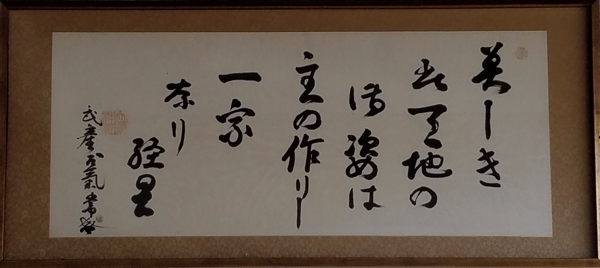
A version of the Iwama monument Doka
from the Hawaii Aiki Kai dojo on Waialae Avenue
calligraphy by Aikido Founder Morihei Ueshiba
Moving on – here’s a photo of the Shomen at the Hawaii Aiki Kai dojo on Waialae Avenue, this is the original Hawaii Aiki “Kwai” dojo that was built in 1961. It was the first dojo in the United States to be built specifically for Aikido, and when the Founder came to dedicate the dojo it was the one and only time that he ever taught Aikido in the United States.
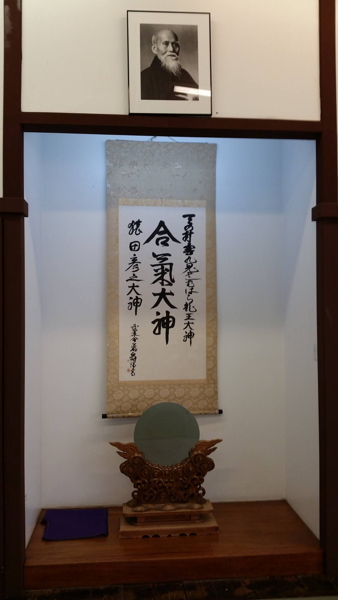
The Shomen at the Hawaii Aiki Kai dojo on Waialae Avenue
When O-Sensei came to Hawaii in 1961 he said:
“I have come to Hawaii in order to build a “silver bridge.” Until now, I have remained in Japan, building a “golden bridge” to unite Japan, but henceforward, I wish to build a bridge to bring the different countries of the world together through the harmony and love contained in Aikido. I think that Aiki, offspring of the martial arts, can unite the people of the world in harmony, in the true spirit of Budo, enveloping the world in unchanging love.”
There’s that bridge reference again – remember it, because it will come up again a little bit later.
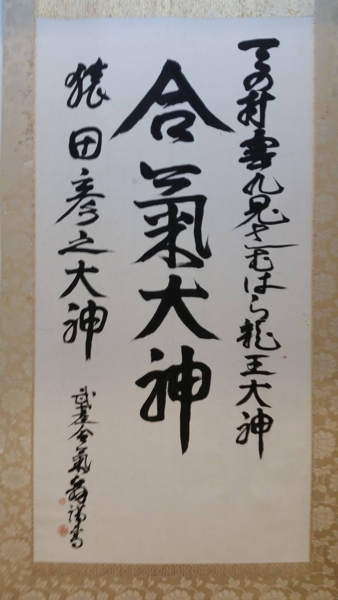
Detail of the Hawaii Aiki Kai dojo scroll
As noted previously, the “Aiki O-Kami” (“Great Gods of Aiki”) in the center of this scroll are expressing the foundation formed by the three creator gods of the Kojiki – representing here the basic Yin-Yang model of paired opposing forces embodied in the Floating Bridge of Heaven mentioned above.
On the top left the kanji reads “Sarutahiko-O-Kami” – a monkey god (luckily, this is being written in the Year of the Monkey!), this god is particularly associated with Misogi, and was one of Morihei Ueshiba’s guardian deities.
The Founder often told Bansen Tanaka 「猿田彦大神の化身じゃ」 – “I am the incarnation of Sarutahiko-O-Kami”.
Further, in 1958 Morihei Ueshiba visited Tsubaki Grand Shrine and said:
“These are the basics of Aikido. Moves which unite the being with the great nature, all of them given by Sarutahiko-no-O-Kami.” He continued, “Aikido is misogi. Misogi of ourselves. Aikido is the way of misogi itself, the way to become Sarutahiko-no-O-Kami and stand on the Ame- no-Ukihashi (the bridge between heaven and earth). In other words, the skills of misogi are Aiki, the way of uniting heaven and earth, the way of world peace, the way of trying to perfect humanity, the way of the Kami, the way of the universe.
There’s that bridge again – which makes sense, since Sarutahiko-O-Kami is, classically – the guardian of the Floating Bridge of Heaven.
So….that’s a second reference to the Floating Bridge.
The kanji in the top right of the scroll reads “Ame-no-murakumo Kuki Samuhara Ryu-ō” ( 天の村雲九鬼さむはら竜王). This phrase, which Morihei Ueshiba stated contains “all the techniques of Aikido” contains quite a lot of information, but we’ll leave a detailed dissection for a later time.
In simple terms – the Founder stated that “Ame-no-murakumo Kuki Samuhara” represents the divine sword whose edges unite Heaven and Earth. In some places he would refer to this sword as 天地人合気の御剣 – “The Divine Sword of Heaven-Earth-Man Aiki”. Once again representing the basic Yin-Yang model of paired opposing forces embodied in the Floating Bridge of Heaven mentioned above.
The last “Ryu-ō” (“Dragon King”) section is important as well, pointing back to Sokaku Takeda, China and India – but we’ll leave that discussion for another time.
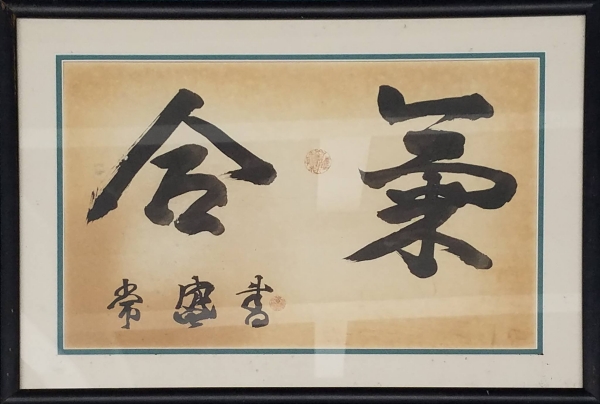 “Aiki” – calligraphy by Aikido Founder Morihei Ueshiba
“Aiki” – calligraphy by Aikido Founder Morihei Ueshiba
from the Hawaii Aiki Kai dojo (originally Hawaii Aiki Kwai)
If it sounds repetitive – it is. Morihei Ueshiba was so repetitive on the basic themes of his method that at times it seems hard to believe that we have had so much difficulty noticing the patterns….
So….three references to the Floating Bridge.
Last kanji – the set at the bottom left of the scroll reads “Takemusu Aiki”. Most people have heard of this one….
There’s a more detailed discussion of this phrase in “Aikido without Peace or Harmony” (and in some of the other articles), but here is the short version:
- “Aiki” was defined by Morihei Ueshiba as matched opposing forces (Yin-Yang forces) – 「合気というものは、初め円を描く。円を描くこと、つまり対象力。」 “In this thing called Aiki, first describe (draw) a circle. Drawing a circle is, in other words, opposing powers.“.
- “Takemusu” was defined by Morihei Ueshiba as the training of attractive force – 「武産とは引力の錬磨であります。」 “Take Musu is the training of Attractive Force.”
- According to Morihei Ueshiba, attractive force is generated when opposing forces are joined by Ki – 「上にア下にオ声と対照で気を結び、そこに引力が発生するのである。」” Above the sound “A” and below the sound “O” – opposites connected with Ki, there Attractive Force (“Inryoku”) is created.“. This is the “unification of opposites” that is so common in Chinese internal martial arts. An interesting note here is that the Founder actually used the phrase “unification of opposites” (陰陽合致) in the 1933 technical manual “Budo Renshu”. Takuma Hisa also used this phrase in “Kannagara no Budo – Daito-ryu Aiki Budo Hiden” (惟神の武道 : 大東流合気武道秘伝) in 1942, published after receiving Menkyo Kaiden in Daito-ryu from Sokaku Takeda.
- According to Kanemoto Sunadomari, Morihei Ueshiba’s biographer, “intent” makes “ki” work – giving us the same basic model that forms the Chinese internal harmonies – the basis of the Chinese internal martial arts: 心と意の合、意と気の合、気と力の合 – “Heart/mind leads intent, intent leads Ki, Ki leads strength/power”.
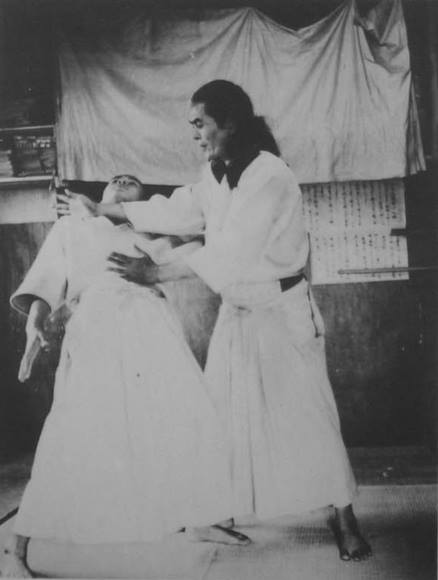
“The connection of intent and the body is the beginning of Aiki.”
– Kanemoto Sunadomari
So…more Yin and Yang (or perhaps, In and Yo, if we’re speaking Japanese) – the basic model represented by the Floating Bridge of Heaven. There is much, much more layered depth and meaning in the scroll, but one way of summarizing would be to say that it expresses Yin and Yang four ways. O-Sensei hammering the basic model of his method and training over and over – kind of a “cheat sheet” of the basic principles of the Silver Bridge that he brought to Hawaii.
Over the years I’ve made a habit of surveying people about this particular calligraphy whenever I stop by the Hawaii Aiki Kai dojo on Waialae Avenue.
Perhaps not surprisingly, I have found that very few people are able to even read the kanji of the scroll that they bow to at the beginning and end of each class. The scroll that they have bowed to (in some cases) for forty or fifty years.
It’s common for instructors from Aikikai Hombu Dojo to visit each year as well, from the junior instructors on their first trips abroad all the way up to Moriteru Ueshiba Doshu and Mitsuteru Ueshiba Waka-sensei (and Kisshomaru Ueshiba Doshu before them).
Of course, the Japanese instructors can generally read the kanji, but discussions with many of these instructors over the years have revealed that, in a reflection of the non-Japanese speakers mentioned above, the number who are able to discuss the meaning of the scroll in any depth is quite small.
I’ll end here with a few thoughts from Masatake Fujita Sensei concerning the importance of the Founder’s words:
I thought that if O-Sensei’s words were preserved than there might be somebody who would be able to follow after them.……..Even among those of high rank, those who don’t understand don’t understand. There are many people who are practicing Aikido today but have never even read a single book about O-Sensei.
Published by: Christopher Li – Honolulu, HI


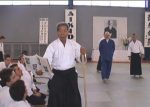
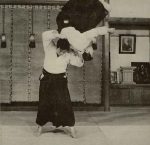



Leave a Reply